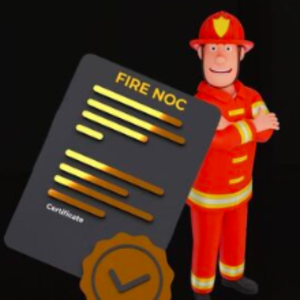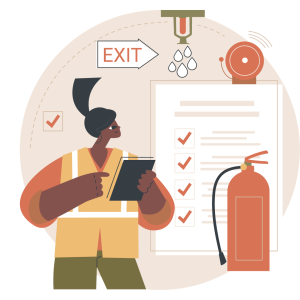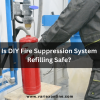![]()
Fire Immuniser
+91-7829629111
Email: info@variex.in
Varistor Technologies Pvt. Ltd.
Block-1, First Floor, Ardente Office One, Hoodi Circle, ITPL Main Road, Bengaluru, Karnataka 560048, IN
Provisional Fir NO Objection Certificate (NOC)
In the realm of safety and building regulations, the Provisional Fire No Objection Certificate (NOC) plays a pivotal role in ensuring that structures adhere to stringent fire safety standards. This document, issued by the local fire department or relevant authorities, serves as an acknowledgment that a building or establishment meets the essential fire safety requirements, albeit on a provisional basis.
Key Components of a Provisional Fire NOC:
1. Site Inspection:
The process of obtaining a Provisional Fire NOC usually begins with a thorough inspection of the premises by fire department officials. Fire department officials aim to evaluate the building's fire safety infrastructure during this inspection. This evaluation includes assessing fire exits, firefighting equipment, and other essential safety measures.
2. Documentation Verification:
3. Compliance Check:
The fire department assesses the building's compliance with local fire safety codes and regulations. The inspection identifies any deficiencies or non-compliance issues, and the authorities may recommend corrective measures to ensure that the structure meets the required safety standards.
4. Emergency Evacuation Plan:
A crucial aspect of obtaining a Provisional Fire NOC is the submission of an effective emergency evacuation plan. This plan outlines procedures for evacuating the building in case of a fire or other emergencies, ensuring the safety of occupants.
Importance of a Provisional Fire NOC:
1. Legal Compliance:
Obtaining a Provisional Fire NOC is often a legal requirement for new constructions or modifications to existing structures. It ensures that the building is in compliance with fire safety regulations, reducing the risk of accidents and enhancing public safety.
2. Occupant Safety:
The primary goal of a Provisional Fire NOC is to safeguard the lives of the building's occupants. Adequate fire safety measures, as assessed during the inspection, contribute to a secure environment, reducing the likelihood of fire-related incidents.
3. Insurance Requirements:
Many insurance providers require businesses and property owners to obtain a Provisional Fire NOC as a prerequisite for coverage. This emphasizes the role of the certificate in mitigating risks and enhancing insurability.
Validity and Renewal:
A Provisional Fire NOC is typically valid for a specified period, after which a renewal is required. The renewal process involves re-evaluating the building's fire safety measures to ensure ongoing compliance with regulations.
Detailed Inspection Process:
The site inspection conducted by the fire department involves a comprehensive examination of various elements:
Fire Exits and Access Routes:
- Evaluation of the number and placement of emergency exits.
- Verification of the accessibility and width of escape routes.
- Inspection of signage indicating evacuation paths.
Firefighting Equipment:
- Assessment of the type and quantity of fire extinguishers installed.
- Verification of the functionality and maintenance records of firefighting equipment.
- Examination of automatic fire suppression systems, if present.
Electrical and Heating Systems:
- Inspection of electrical wiring and systems to ensure they meet safety standards.
- Assessment of heating equipment and appliances for potential fire hazards.
Building Structure:
- Evaluation of the construction materials used and their fire resistance properties.
- Verification of fire-rated walls and barriers.
Occupancy Load:
- Assessment of the maximum occupancy load to ensure that it aligns with safety regulations.
Corrective Measures:
If deficiencies are identified during the inspection, the fire department may issue recommendations for corrective measures. These may include:
- Upgrading or adding fire safety equipment.
- Implementing changes to improve emergency evacuation routes.
- Enhancing fire-resistant materials in specific areas.
- Conducting employee training on fire safety protocols.
Emergency Evacuation Plan:
The submission of an effective emergency evacuation plan is a critical component. This plan should include:
- Clearly marked evacuation routes and assembly points.
- Procedures for notifying occupants of a fire or emergency.
- Designation of responsible personnel for coordinating evacuations.
- Regular drills to ensure that occupants are familiar with evacuation procedures.
Legal Consequences of Non-Compliance:
Failure to obtain or renew a Provisional Fire NOC can lead to legal consequences, including fines and penalties. Additionally, non-compliance may result in the closure of the establishment until necessary safety measures are implemented.
Collaboration with Fire Safety Consultants:
Building owners often engage fire safety consultants to conduct a pre-inspection review before the official fire department assessment. This proactive approach helps identify potential issues and ensures a smoother inspection process.
Community Awareness:
In addition to individual building safety, Provisional Fire NOCs contribute to overall community resilience. Public awareness campaigns about fire safety and the importance of compliance with regulations can further enhance community safety.
Technology Integration:
The use of technology, such as advanced fire detection and suppression systems, is increasingly becoming a part of fire safety measures. Integration with smart building technologies allows for real-time monitoring and early detection of potential fire hazards.
Global Standards and Certification:
In some cases, establishments may adhere to international standards for fire safety. Certification from recognized global bodies can enhance the credibility of the fire safety measures in place.
Conclusion:
In conclusion, the Provisional Fire NOC is a crucial document that underscores the commitment to fire safety in buildings and establishments. Building owners and managers must prioritize obtaining and maintaining this certificate to uphold the highest standards of safety, protect occupants, and adhere to legal and insurance requirements. By doing so, they contribute to the overall well-being and resilience of the community.
Frequently Asked Questions (FAQs)
1. What is a Provisional Fire NOC?
- The local fire department or relevant authorities issue an official document called a Provisional Fire No Objection Certificate (NOC). This document indicates that a building or establishment meets essential fire safety requirements on a provisional basis.
2. Why is a Provisional Fire NOC necessary?
- It is necessary to ensure that buildings comply with fire safety regulations, thereby reducing the risk of fire-related incidents. The NOC is often a legal requirement for new constructions, modifications, and renovations.
3. How is the Provisional Fire NOC obtained?
- The process involves a detailed site inspection by the fire department, verification of documentation related to fire safety measures, and assessment of compliance with local fire safety codes. Corrective measures may be recommended for deficiencies.
4. What does the inspection process involve?
- The inspection covers various aspects, including fire exits, firefighting equipment, electrical and heating systems, building structure, and occupancy load. It aims to ensure that the building is equipped to handle fire emergencies.
5. How long is a Provisional Fire NOC valid?
- The validity period varies and is typically specified by the issuing authority. After the initial period, building owners are required to renew the certificate by undergoing a re-evaluation of fire safety measures.
6. Are there consequences for non-compliance?
- Yes, non-compliance can result in legal consequences, including fines, penalties, and the potential closure of the establishment until necessary safety measures are implemented.
7. Can corrective measures be recommended after the inspection?
- Yes, if deficiencies are identified, the fire department may issue recommendations for corrective measures. This could include upgrading or adding fire safety equipment, improving evacuation routes, or implementing changes to enhance fire resistance.
Final Say
At VariEx.in , we excel in navigating the intricacies of Fire NOC processes. Our expertise extends to designing, installing, inspecting, and rectifying automatic sprinkler systems. With our proficient in-house team, we offer comprehensive fire sprinkler services tailored to your needs, ensuring both quality and affordability.
Whether your project is extensive or compact, we stand ready to fulfill your Fire NOC requirements. To initiate a Fire NOC consultation or explore how our services can enhance the safety of your premises, reach out to us online or contact us at 7829629111. We are committed to delivering reliable solutions for your fire safety needs.











